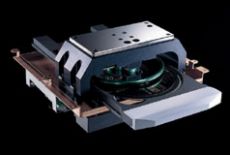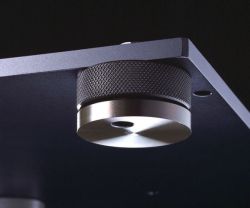|
| REVIEW |
| Τeac
Esoteric P70/D70 |
|
|
|
| DESCRIPTION... |
|
|
| The
VDRS mechanism consists -since many years- Teac's
proposal for the CD optimum optical reading. We meet it here in
the CMK3 version which includes a large
platter with parts of bronze and aluminum, that is
driven directly by a motor with samarian-cobalt magnets. The system
is inverted, i.e. clamp is moving upwards in order to push the disk
to the platter. The basic idea here, is that the platter is not flat
but has a very smooth slope of about 0.5 degrees and that the
linear moving laser pick up is moving at the same angle. This
geometry ensures absolute stable distance between optical head and
the disk and the best possible tracking conditions. The
transport unit is constructed with
massive componentsand its appearance is in absolute step
with... the industrial noises that accompany the import of each
disk in the player unit. |
 |
 |
| The VRDS
CMK3 naked. Motor lyes on the upper part. |
Close up of
VRDS the moment that the disk is inserted. Platter is of green
colour so any light leak is
avoided. | |
|
|
| Nevertheless,
it is not only the VRDS which permits to P70 reaching top
levels of performance: Teac has chosen the strategic of
Digital-to-Digital conversion at the transport
side, using a FPGA of Xilinx (the Spartan) in order to make
upsampling x2 and x4 in 24 bit allowing the digital
signal to reach 88,2 or 176,4 kHz. The algorithm used for
the upsampling is covered by the RDOT name. Additionally, the
transport can be synchronized from the following unit through the
word clock input, minimizing the jitter problems. The Esoteric's
people have foreseen another step: The P70 can accept clock signal
from an external source and provides a pass through output to the
rest of the appliances. Where it will find it? Such
a product exists in the Esoteric series, but only in the
japanese market (for the time being). Finally, the user has in his
disposition a big variety of outputs, which include humble
toshlinks, coaxials with connectors of excellent quality and double
AES3. Among these, the two optical and one of the coaxials support
only 44.1kHz, one optical and one coaxial support 44,1 and
88.2kHz sample rates and the pair of AES3
supports 176,4kHz sample rate. AES3 is the
more recent incarnation of the known professional protocol
AES/EBU with balanced transmission line in a version where it is
used one line for every channel (the conventional AES/EBU is
multiplexed), probably for the x4 upsampling to be supported.
The happy owner of a D70 uses these outputs in combination with the
word clocking line in order to get the ultimate result. As
to other details, P70 has all classic values:
it is heavy (only the base weighs eight kilograms,
the transport being over twenty five in total), it has
three-point support base with embodied spikes and a
strict and functional aesthetics. Finally, it is accompanied by a
remote control of high quality. |
 |
 |
| Inside P70
one can see the FPGA Spartan of Xilinx. (upper and slightly to
the right) |
Analog stage
of D70 is well cared but without exaggerations. The
secrect is elsewhere.. | |
|
|
| With the
(rather annoying, as I've already said) low profile attitude used by
Teac, the company formaly described the D70 as a multibit D/A
converter. The output stage is such indeed, without exploring
new paths, it might be even characterized by someone rather
conservative: Two DAC chips from Burr
Brown, the classic 24bit/96kHz PCM
1704 in fully balanced configuration per channel (BB
reports that PCM 1704 is laser trimmed for minimal differential
non-linearity but, it's better to be safe...) and one analog part of
good quality, as expected, with ICs of Analog Devices and -again-
from Burr Brown for i/v conversion, low pass filter
and buffering with passive components of good quality and
non-existing cables are Teac's weapons to the single
ended part which is combined with a
balanced version also, for those who would like
this kind of connection as to the preamplifier. A double
power supply, eight different local
regulators blah blah blah... You can refer
to the review of any top player for such details. All the
essence, as you have probably understood, is on the digital part.
The D70 starts with an SDRAM of 128Mbits which
has the role of the buffer before processing, allowing use of
signals from 44.1 to 192kHz. Memory reading
is controled by a clock signal which is produced
locally and at the same time it can be output to the transport so
that the jitter will be minimized. The D70's most
interesting part is the upsampling. We have two
different groups of digital filters used here, the
classic FIR (which is compatible with the HDCD and
the Teac's proprietary RDOT (Refined Digital Output
Technology). The user can select each algorithm separately having
also choices as to the upsampling ratio or their application in
series too. The system can operate signals till 24bit/768kHz and
having this limit kept, a custom filter choice is also
possible. |
|
 |
Base of P70/D70 weighs eight kilos,
so that stiffness and minimum level of vibrations to be
obtained. Feet have embodied
spikes. | |
|
|
| When I
have reviewed DV50 for the DVD Home Theater magazine, it
is true that I had suspected that RDOT is just another one digital
filter which simply sounds better, a properly materialized marketing
idea actually. Investigation thoug,h has brought to the surface
other facts: The RDOT is a digital filter the algorithm of which is
based on the ideas of professor Kozuo Toraichi (of
the Tsukuba University). Toraichi has described the
Fluency Function that approximates values
of a digitalized sign with a different way. Data as to this
procedure are not widely known (and most probably not even
absolutely understandable for the outsider!) but the indications
converge to the impression that in contrast with the
conventional digital filters which being low pass (according to
Shannon theorem of sampling function) in the frequency domain,
filters that are based on the ideas of Toraichi, function in
the time domain allowing (in theory) creation of frequencies
over the half of the sampling frequency. Ok ok, to cut the long
story short: With the RDOT, D-70 can reproduce
frequencies above 20kHz, at least this is
mentioned by Teac. A fair question: from where this
information is coming, since the anti-aliasing filters used
during digitization cut anything out above 20kHz? Probably we have a
lot of things to learn about as to this point. But the interesting
part is that Fluency algorithm has been used for the first time
long long time ago: by the awarded Luxman's DAC DA-07 in 1988!
The fact that this DAC too had caused great enthusiasm,
it can't be a simple coincidence. It is also fair to note
that -obviously- the algorithm has been improved since then, as well
as the ways to transfer it to hardware. The D70's user has in his
disposition a wide input variety (toshlink, coaxial and of course
AES3) a digital output (toshlink) and an
option for IEEE1394 input where SACD or
DVD-Audio connection will be possible "when specifications will
be stabilized" according to the company's sayings. As to analog
outputs, there is a single ended set and a balanced one. Unit
provides also digital level attenuation
with bit truncation (meaning that resolution is reduced as the level
is reduced -in other words it is better the level control to be
adjusted at 0dB and stay there) therefore someone could see the D70
as a top digital preamplifier which can drive
directly power amplifiers. Weight, aesthetics and the remote control
are similar to P70 design. |
|
| |
|